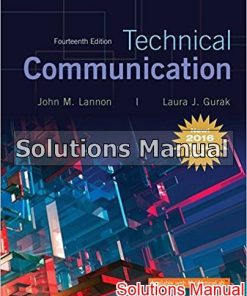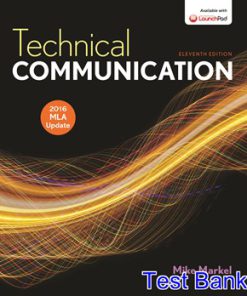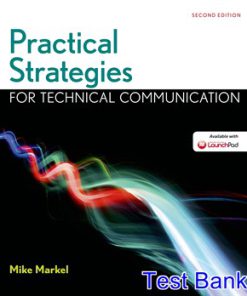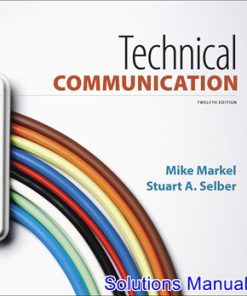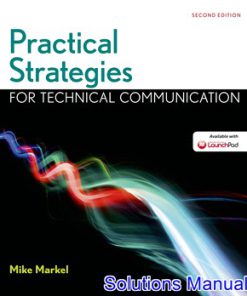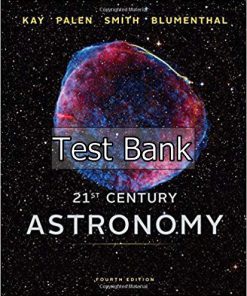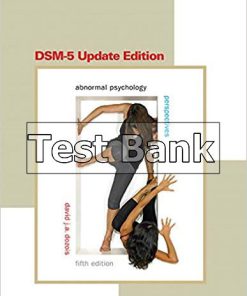$26.50$50.00 (-47%)
In stock
Technical Communication 11th Edition Markel Test Bank.
You may also like
Technical Communication 11th Edition Markel Test Bank

Product details:
- ISBN-10 : 1457673371
- ISBN-13 : 978-1457673375
- Author: Michael H. Markel
Instructors know that Mike Markel’s Technical Communication will prepare their students for any workplace writing situation. No other text offers such a comprehensive introduction to the field while still delivering practical, effective support for students at every level. The eleventh edition has been thoroughly revised to reframe the work of technical communicators in the context of today’s highly collaborative, rapidly evolving digital practices. Fresh, social-media driven sample documents and coverage of the latest tools and technologies ensure that students work with the kinds of processes and products they’ll encounter on the job.
The text is now accompanied and enhanced by LaunchPad for Technical Communication, an online course space with an interactive e-book, multimedia sample documents for analysis, tutorials on digital writing tools, a new test bank, Learning Curve adaptive quizzes that give students more ways to master the material, and much more. Get all our great course-specific materials in one fully customizable space online; then assign and mix our resources with yours.
Table contents:
PART 1
Understanding the Technical Communication Environment
1 Introduction to Technical Communication
What Is Technical Communication?
The Challenges of Producing Technical Communication
Characteristics of a Technical Document
Measures of Excellence in Technical Documents
Skills and Qualities Shared by Successful Workplace Communicators
How Communication Skills and Qualities Affect Your Career
A Look at Three Technical Documents
Exercises
LearningCurve: Understanding the Technical Communication Environment [LaunchPad]
Case 1: Using the Measures of Excellence in Evaluating a Resume [LaunchPad]
2 Understanding Ethical and Legal Considerations
A Brief Introduction to Ethics
Your Ethical Obligations
Obligations to Your Employer
Obligations to the Public
Obligations to the Environment
Your Legal Obligations
Copyright Law
Guidelines: Determining Fair Use
Guidelines: Dealing with Copyright Questions
Ethics Note: Distinguishing Plagiarism from Acceptable Reuse of Information
Trademark Law
Guidelines: Protecting Trademarks
Contract Law
Liability Law
Guidelines: Abiding by Liability Laws
The Role of Corporate Culture in Ethical and Legal Conduct
Understanding Ethical and Legal Issues Related to Social Media
Guidelines: Using Social Media Ethically and Legally
Document Analysis Activity: Presenting Guidelines for Using Social Media
Communicating Ethically Across Cultures
Communicating with Cultures with Different Ethical Beliefs
Communicating with Cultures with Different Laws
Principles for Ethical Communication
Abide by Relevant Laws
Abide by the Appropriate Professional Code of Conduct
Abide by Your Organization’s Policy on Social Media
Take Advantage of Your Employer’s Ethics Resources
Tell the Truth
Don’t Mislead Your Readers
Use Design to Highlight Important Ethical and Legal Information
Be Clear
Avoid Discriminatory Language
Acknowledge Assistance from Others
Writer’s Checklist
Exercises
LearningCurve: Understanding the Technical Communication Environment [LaunchPad]
Case 2: The Ethics of Requiring That Students Subsidize a Plagiarism-Detection Service [LaunchPad]
3 Writing Technical Documents
Planning
Analyzing Your Audience
Analyzing Your Purpose
Choosing Your Writing Tools
Tutorial: Cross-Platform Word Processing with CloudOn, Quip, and More [LaunchPad] Generating Ideas About Your Subject
Researching Additional Information
Organizing and Outlining Your Document
Tech Tip: How to Use the Outline View
Tutorial: Creating Outlines [LaunchPad]
Tutorial: Creating Styles and Templates [LaunchPad]
Selecting an Application, a Design, and a Delivery Method
Devising a Schedule and a Budget
Drafting
Using Templates
Guidelines: Drafting Effectively
Tech Tip: How to Modify Templates
Document Analysis Activity: Identifying the Strengths and Weaknesses of a Commercial Template
Using Styles
Tech Tip: How to Use the Styles Group
Revising
Studying the Draft by Yourself
Seeking Help from Others
Ethics Note: Acknowledging Reviewers Responsibly
Tutorial: Creating Styles and Templates [LaunchPad]
Editing
Proofreading
Tutorial: Proofreading for Format Consistency [LaunchPad]
Writer’s Checklist
Exercises
LearningCurve: Understanding the Technical Communication Environment [LaunchPad]
Case 3: Understanding Why Revision Software Cannot Revise and Edit Your Document [LaunchPad]
4 Writing Collaboratively
Advantages and Disadvantages of Collaboration
Advantages of Collaboration
Disadvantages of Collaboration
Team Writing Assignment Modules [LaunchPad]
Managing Projects
Guidelines: Managing Your Project
Conducting Meetings
Listening Effectively
Guidelines: Listening Effectively
Tutorial: Scheduling Online Meetings [LaunchPad]
Setting Your Team’s Agenda
Guidelines: Setting Your Team’s Agenda
Downloadable Form: Work-Schedule Form [LaunchPad]
Downloadable Form: Team-Member Evaluation Form [LaunchPad]
Downloadable Form: Self-Evaluation Form [LaunchPad]
Ethics Note: Pulling Your Weight on Collaborative Projects
Conducting Efficient Meetings
Communicating Diplomatically
Critiquing a Team Member’s Work
Guidelines: Communicating Diplomatically
Guidelines: Critiquing a Colleague’s Work
Using Social Media and Other Electronic Tools in Collaboration
Word Processing Tools
Tech Tip: How to Use the Review Tab
Document Analysis Activity: Critiquing a Draft Clearly and Diplomatically
Tutorial: Reviewing Collaborative Documents [LaunchPad]
Tutorial: Incorporating Tracked Changes [LaunchPad]
Messaging Technologies
Guidelines: Representing Your Organization on a Microblog
Tutorial: Using Collaborative Software [LaunchPad]
Videoconferencing
Tutorial: Using Collaborative Software [LaunchPad]
Guidelines: Participating in a Videoconference
Wikis and Shared Document Workspaces
Tutorial: Using Wikis for Collaborative Work [LaunchPad]
Virtual Worlds
Ethics Note: Maintaining a Professional Presence Online
Gender and Collaboration
Culture and Collaboration
Writer’s Checklist
Exercises
LearningCurve: Understanding the Technical Communication Environment [LaunchPad]
Case 4: Accommodating a Team Member’s Scheduling Problems [LaunchPad]
PART 2
Planning the Document
5 Analyzing Your Audience and Purpose
Understanding Audience and Purpose
Using an Audience Profile Sheet
Downloadable Forms: Audience Profile Sheet [LaunchPad]
Determining the Important Characteristics of Your Audience
Who Are Your Readers?
Why Is Your Audience Reading Your Document?
What Are Your Readers’ Attitudes and Expectations?
How Will Your Readers Use Your Document?
Techniques for Learning About Your Audience
Determining What You Already Know About Your Audience
Interviewing People
Reading About Your Audience Online
Searching Social Media for Documents Your Audience Has Written
Analyzing Social-media Data
Communicating Across Cultures
Understanding the Cultural Variables “on the Surface”
Understanding the Cultural Variables “Beneath the Surface”
Considering Cultural Variables as You Write
Guidelines: Writing for Readers from Other Cultures
Document Analysis Activity: Examining Cultural Variables in a Business Letter
Using Graphics and Design for Multicultural Readers
Applying What You Have Learned About Your Audience
Ethics Note: Meeting Your Readers’ Needs Responsibly
Writing for Multiple Audiences
Determining Your Purpose
Gaining Management’s Approval
Revising Information for a New Audience and Purpose
Writer’s Checklist
Exercises
LearningCurve: Analyzing Your Audience and Purpose [LaunchPad]
Case 5: Focusing on An Audience’s Needs and Interests [LaunchPad]
6 Researching Your Subject
Understanding the Differences Between Academic and Workplace Research
Understanding the Research Process
Choosing Appropriate Research Methods
Guidelines: Researching a Topic
Conducting Secondary Research
Understanding the Research Media
Using Traditional Research Tools
Online Catalogs
Reference Works
Periodical Indexes
Newspaper Indexes
Abstract Services
Government Information
Using Social Media and Other Interactive Resources
Discussion Boards
Wikis
Blogs
Tagged Content
Tutorials: Tracking Sources with Evernote and Zotero [LaunchPad]
RSS Feeds
Evaluating the Information
Guidelines: Evaluating Print and Online Sources
Document Analysis Activity: Evaluating Information from Internet Sources
Conducting Primary Research
Analyzing Social Media Data
Observations and Demonstrations
Inspections
Experiments
Field Research
Interviews
Guidelines: Conducting an Interview
Inquiries
Questionnaires
Asking Effective Questions
Testing the Questionnaire
Administering the Questionnaire
Presenting Questionnaire Data in Your Document
Ethics Note: Reporting and Analyzing Data Honestly
Writer’s Checklist
Exercises
LearningCurve: Researching Your Subject [LaunchPad]
Case 6: Revising a Questionnaire [LaunchPad]
7 Organizing Your Information
Understanding Three Principles for Organizing Technical Information
Analyzing Your Audience and Purpose
Using Conventional Patterns of Organization
Displaying Your Organizational Pattern Prominently
Understanding Conventional Organizational Patterns
Chronological
Guidelines: Organizing Information Chronologically
Spatial
Guidelines: Organizing Information Spatially
General to Specific
Guidelines: Organizing Information from General to Specific
More Important to Less Important
Guidelines: Organizing Information from More Important to Less Important
Comparison and Contrast
Guidelines: Organizing Information by Comparison and Contrast
Ethics Note: Comparing and Contrasting Fairly
Classification and Partition
Guidelines: Organizing Information by Classification or Partition
Problem-Methods-Solution
Guidelines: Organizing Information by Problem-Methods-Solution
Cause and Effect
Guidelines: Organizing Information by Cause and Effect
Document Analysis Activity: Using Multiple Organizational Patterns in an Infographic
Writer’s Checklist
Chronological and Spatial
General to Specific
More Important to Less Important
Comparison and Contrast
Classification and Partition
Problem-Methods-Solution
Cause and Effect
Exercises
LearningCurve: Organizing and Emphasizing Information [LaunchPad]
Case 7: Organizing a Document for Clarity — and Diplomacy [LaunchPad]
PART 3
Developing and Testing the Verbal and Visual Information
8 Communicating Persuasively
Considering the Context of Your Argument
Understanding Your Audience’s Broader Goals
Security
Recognition
Growth
Connectedness
Working Within Constraints
Ethical Constraints
Legal Constraints
Political Constraints
Informational Constraints
Personnel Constraints
Financial Constraints
Time Constraints
Format and Tone Constraints
Crafting a Persuasive Argument
Identifying the Elements of Your Argument
Using the Right Kinds of Evidence
Considering Opposing Viewpoints
Document Analysis Activity: Analyzing Evidence in an Argument
Appealing to Emotions Responsibly
Deciding Where to Present the Claim
Understanding the Role of Culture in Persuasion
Avoiding Logical Fallacies
Presenting Yourself Effectively
Guidelines: Creating a Professional Persona
Using Graphics as Persuasive Elements
Ethics Note: Seeming Honest Versus Being Honest In Persuasive Writing
A Look at Several Persuasive Arguments
Writer’s Checklist
Exercises
LearningCurve: Communicating Persuasively [LaunchPad]
Case 8: Analyzing the Persuasiveness of a Web Site [LaunchPad]
9 Emphasizing Important Information
Writing Clear, Informative Titles
Writing Clear, Informative Headings
Tech Tip: How to Modify and Create Styles
Guidelines: Revising Headings
Writing Clear, Informative Lists
Write Effective Paragraph Lists
Write Effective Sentence Lists
Guidelines: Creating Effective Lists
Tech Tip: How to Create Numbered and Bulleted Lists
Writing Clear, Informative Paragraphs
Structure Paragraphs Clearly
The Topic Sentence
Ethics Note: Avoiding Burying Bad News in Paragraphs
The Supporting Information
Paragraph Length
Guidelines: Dividing Long Paragraphs
Use Coherence Devices Within and Between Paragraphs
Adding Transitional Words and Phrases
Repeating Key Words
Using Demonstrative Pronouns Followed by Nouns
Document Analysis Activity: Identifying the Elements of a Coherent Paragraph
Writer’s Checklist
Exercises
LearningCurve: Organizing and Emphasizing Information [LaunchPad]
Case 9: Emphasizing Important Information in a Technical Description [LaunchPad]
10 Writing Correct and Effective Sentences
Writing Grammatically Correct Sentences
Avoid Sentence Fragments
Avoid Comma Splices
Avoid Run-on Sentences
Avoid Ambiguous Pronoun References
Compare Items Clearly
Use Adjectives Clearly
Maintain Subject-Verb Agreement
Maintain Pronoun-Antecedent Agreement
Use Tenses Correctly
Structuring Effective Sentences
Emphasize New and Important Information
Choose an Appropriate Sentence Length
Avoid Overly Long Sentences
Avoid Overly Short Sentences
Focus on the “Real” Subject
Focus on the “Real” Verb
Use Parallel Structure
Use Modifiers Effectively
Distinguish Between Restrictive and Nonrestrictive Modifiers
Avoid Misplaced Modifiers
Avoid Dangling Modifiers
Choosing the Right Words and Phrases
Select an Appropriate Level of Formality
Be Clear and Specific
Use Active and Passive Voice Appropriately
Be Specific
Avoid Unnecessary Jargon
Use Positive Constructions
Avoid Long Noun Strings
Avoid Clichés
Avoid Euphemisms
Ethics Note: Euphemisms and Truth Telling
Be Concise
Avoid Obvious Statements
Avoid Filler
Avoid Unnecessary Prepositional Phrases
Avoid Wordy Phrases
Avoid Fancy Words
Use Inoffensive Language
Document Analysis Activity: Revising for Conciseness and Simplicity
Use Nonsexist Language
Guidelines: Avoiding Sexist Language
Use Inoffensive Language When Referring to People with Disabilities
Guidelines: Using the People-First Approach
Understanding Simplified English for Nonnative Speakers
Preparing Text for Translation
Writer’s Checklist
Grammar
Sentences
Words and Phrases
Exercises
LearningCurve: Organizing and Emphasizing Information [LaunchPad]
Case 10: Revising a Document for Nonnative Speakers and for Translation [LaunchPad]
11 Designing Print and Online Documents
Goals of Document Design
Understanding Design Principles
Proximity
Alignment
Repetition
Contrast
Planning the Design of Print and Online Documents
Analyze Your Audience and Purpose
Determine Your Resources
Designing Print Documents
Size
Paper
Tech Tip: How to Set Up Pages
Bindings
Accessing Aids
Designing Print Pages
Guidelines: Understanding Learning Theory and Page Design
Page Layout
Page Grids
White Space
Columns
Typography
Tech Tip: How to Format Columns
Typefaces
Type Families
Tech Tip: How to Format Fonts
Case
Type Size
Ethics Note: Using Type Sizes Responsibly
Line Length
Line Spacing
Justification
Tech Tip: How to Modify Line Spacing
Tech Tip: How to Modify Justification
Titles and Headings
Titles
Headings
Other Design Features
Tech Tip: How to Create Borders and Screens
Tech Tip: How to Create Text Boxes
Analyzing Several Print-Document Designs
Document Analysis Activity: Analyzing a Page Design
Designing Online Documents
Use Design to Emphasize Important Information
Create Informative Headers and Footers
Help Readers Navigate the Document
Guidelines: Making Your Document Easy to Navigate
Include Extra Features Your Readers Might Need
Help Readers Connect with Others
Design for Readers with Disabilities
Design for Multicultural Audiences
Ethics Note: Designing Legal and Honest Online Documents
Designing Online Pages
Aim for Simplicity
Guidelines: Designing a Simple Site
Make the Text Easy to Read and Understand
Guidelines: Designing Easy-To-Read Text
Create Clear, Informative Links
Guidelines: Writing Clear, Informative Links
Analyzing Several Online Document Designs
Writer’s Checklist
Designing Print Documents and Pages
Designing Online Documents
Exercises
Case 11: Designing a Flyer [LaunchPad]
12 Creating Graphics
The Functions of Graphics
The Characteristics of an Effective Graphic
Ethics Note: Creating Honest Graphics
Guidelines: Integrating Graphics and Text
Understanding the Process of Creating Graphics
Planning Graphics
Producing Graphics
Tech Tip: How to Insert and Modify Graphics
Revising Graphics
Citing Graphics
Using Color Effectively
Choosing the Appropriate Kind of Graphic
Illustrating Numerical Information
Tables
Guidelines: Creating Effective Tables
Bar Graphs
Tech Tip: How to Use Tab Stops
Tech Tip: How to Create Tables
Tech Tip: How to Create Graphics in Excel
Guidelines: Creating Effective Bar Graphs
Infographics
Guidelines: Creating Effective Infographics
Tech Tip: How to Use Drawing Tools
Line Graphs
Guidelines: Creating Effective Line Graphs
Pie Charts
Guidelines: Creating Effective Pie Charts
Illustrating Logical Relationships
Diagrams
Organization Charts
Document Analysis Activity: Analyzing a Graphic
Illustrating Process Descriptions and Instructions
Checklists
Flowcharts
Logic Trees
Techniques for Showing Motion
Tutorials: Audio Recording & Editing with Audacity [LaunchPad]
Illustrating Visual and Spatial Characteristics
Photographs
Guidelines: Presenting Photographs Effectively
Screen Shots
Tech Tip: How to Create and Insert Screen Shots
Line Drawings
Maps
Tutorials: Photo Editing Basics with GIMP [LaunchPad]
Creating Effective Graphics for Multicultural Readers
Writer’s Checklist
Exercises
Case 12: Creating Appropriate Graphics to Accompany a Report [LaunchPad]
13 Reviewing, Evaluating, and Testing Documents and Web Sites
Understanding Reviewing, Evaluating, and Testing
Reviewing Documents and Web Sites
Revising
Editing
Guidelines: Editing the Draft
Proofreading
Conducting Usability Evaluations
Conducting Usability Tests
The Basic Principles of Usability Testing
Preparing for a Usability Test
Conducting a Usability Test
Interacting with the Test Participant
Ethics Note: Understanding the Ethics of Informed Consent
Debriefing the Test Participant
Interpreting and Reporting the Data from a Usability Test
Document Analysis Activity: Obtaining Informed Consent
Writer’s Checklist
Revising, Editing, and Proofreading
Usability Evaluations
Usability Tests
Exercises
Case 13: Revising a Document for a New Audience [LaunchPad]
PART 4
Learning Important Applications
14 Writing Correspondence
Understanding the Process of Writing Correspondence
Selecting a Type of Correspondence
Presenting Yourself Effectively in Correspondence
Use the Appropriate Level of Formality
Communicate Correctly
Project the “You Attitude”
Avoid Correspondence Clichés
Communicate Honestly
Ethics Note: Writing Honest Business Correspondence
Writing Letters
Elements of a Letter
Common Types of Letters
Inquiry Letter
Response to an Inquiry
Claim Letter
Adjustment Letter
Writing Memos
Guidelines: Organizing a Memo
Writing E-mails
Guidelines: Following Netiquette
Document Analysis Activity: Following Netiquette in an E-mail Message
Writing Microblogs
Guidelines: Representing Your Organization on a Microblog
Writing Correspondence to Multicultural Readers
Writer’s Checklist
Letter Format
Types of Letters
Memos
E-mail
Microblogs
Exercises
Case 14: Setting Up and Maintaining a Professional Microblog Account [LaunchPad]
15 Writing Job-Application Materials
Understanding the Job-Application Process
Establishing Your Personal Brand
Understand What Employers Want
Guidelines: Building the Foundation of Your Personal Brand
Craft Your Personal Brand
Guidelines: Presenting Your Personal Brand
Tutorial: Building Your Personal Brand with LinkedIn, Twitter, and More [LaunchPad]
Ethics Note: Writing Honest Job-Application Materials
Planning the Job Search
Understanding Four Major Ways to Look for a Position
Guidelines: Using LinkedIn’s Employment Features
Writing Résumés
Elements of the Chronological Résumé
Identifying Information
Summary Statement
Education
Guidelines: Elaborating on Your Education
Employment History
Interests and Activities
References
Other Elements
Elements of the Skills Résumé
Preparing a Plain-text Résumé
Guidelines: Formatting a Plain-Text Résumé
Document Analysis Activity: Preparing a Text Résumé
Document Analysis Activity: Professional Website Featuring an Infographic Résumé [LaunchPad]
Writing Job-Application Letters
Preparing for a Job Interview
Guidelines: Preparing for a Job Interview
Writing Follow-up Letters or E-mails After an Interview
Writer’s Checklist
Résumé
Job-Application Letter
Preparing for a Job Interview
Follow-up Letters
Exercises
Case 15: Identifying the Best-of-the-Best Job-search Sites [LaunchPad]
16 Writing Proposals
Understanding the Process of Writing Proposals
The Logistics of Proposals
Internal and External Proposals
Internal Proposals
External Proposals
Solicited and Unsolicited Proposals
Solicited Proposals
Unsolicited Proposals
The “Deliverables” of Proposals
Research Proposals
Goods and Services Proposals
Persuasion and Proposals
Understanding Readers’ Needs
Readers’ Needs in an Internal Proposal
Readers’ Needs in an External Proposal
Describing What You Plan to Do
Demonstrating Your Professionalism
Guidelines: Demonstrating Your Professionalism in a Proposal
Ethics Note: Writing Honest Proposals
Writing a Proposal
The Structure of the Proposal
Summary
Introduction
Guidelines: Introducing a Proposal
Proposed Program
Qualifications and Experience
Document Analysis Activity: Writing the Proposed Program
Document Analysis Activity: Proposal Delivered as a Prezi Presentation [LaunchPad]
Budget
Appendixes
Task Schedule
Tables
Bar Charts
Tech Tip: How to Create a Gantt Chart
Network Diagrams
Description of Evaluation Techniques
Sample Internal Proposal
Writer’s Checklist
Exercises
Case 16: Revising a Brief Proposal [LaunchPad]
17 Writing Informational Reports
Understanding the Process of Writing Informational Reports
Writing Directives
Document Analysis Activity: Writing a Persuasive Directive
Document Analysis Activity: Report Presented as a Website [LaunchPad]
Document Analysis Activity: Informational Report Presented through Interactive Graphics [LaunchPad]
Writing Field Reports
Guidelines: Responding to Readers’ Questions in a Field Report
Writing Progress and Status Reports
Ethics Note: Reporting Your Progress Honestly
Organizing Progress and Status Reports
Concluding Progress and Status Reports
Guidelines: Projecting an Appropriate Tone in a Progress or Status Report
Sample Progress Report
Writing Incident Reports
Writing Meeting Minutes
Writer’s Checklist
Exercises
Case 17: Writing a Directive About Using Agendas for Meetings [LaunchPad]
18 Writing Recommendation Reports
Understanding the Role of Recommendation Reports
Using a Problem-Solving Model for Preparing Recommendation Reports
Identify the Problem or Opportunity
Establish Criteria for Responding to the Problem or Opportunity
Determine the Options
Study Each Option According to the Criteria
Draw Conclusions About Each Option
Formulate Recommendations Based on the Conclusions
Ethics Note: Presenting Honest Recommendations
Writing Recommendation Reports
Writing the Body of the Report
Introduction
Methods
Results
Conclusions
Recommendations
Guidelines: Writing Recommendations
Writing the Front Matter
Letter of Transmittal
Cover
Title Page
Abstract
Table of Contents
List of Illustrations
Executive Summary
Tech Tip: How to Format Headers, Footers, and Page Numbers
Tech Tip: How to Create a Table of Contents
Guidelines: Writing an Executive Summary
Document Analysis Activity: Analyzing an Executive Summary
Writing the Back Matter
Glossary and List of Symbols
References
Appendixes
Sample Recommendation Report
Writer’s Checklist
Exercises
Case 18: Analyzing Decision Matrices [LaunchPad]
19 Writing Lab Reports
Persuasion and Lab Reports
Understanding the Process of Writing Lab Reports
Understanding the Structure of the Lab Report
Title
Abstract
Introduction
Guidelines: Writing Equations
Materials and Methods
Results
Ethics Note: Presenting Data Honestly
Discussion
Conclusion
Acknowledgments
References
Appendixes
Understanding the Role of Science and Engineering Articles
Sample Lab Report
Writer’s Checklist
Exercises
Case 19: Introducing the Scientific Method Through a Lab Report [LaunchPad]
20 Writing Definitions, Descriptions, and Instructions
Writing Definitions
Analyzing the Writing Situation for Definitions
Determining the Kind of Definition to Write
Writing Parenthetical Definitions
Writing Sentence Definitions
Guidelines: Writing Effective Sentence Definitions
Writing Extended Definitions
Graphics
Examples
Partition
Principle of Operation
Comparison and Contrast
Analogy
Negation
Etymology
A Sample Extended Definition
Deciding Where to Place the Definition
Writing Descriptions
Analyzing the Writing Situation for Descriptions
Indicating Clearly the Nature and Scope of the Description
Introducing the Description Clearly
Providing Appropriate Detail
Guidelines: Providing Appropriate Detail in Descriptions
Concluding the Description
A Look at Several Sample Descriptions
Writing Instructions
Understanding the Role of Instructional Videos
Designing a Set of Written Instructions
Guidelines: Designing Clear, Attractive Pages
Planning for Safety
Ethics Note: Protecting Your Readers’ Safety
Drafting Effective Instructions
Drafting Titles
Drafting General Introductions
Guidelines: Drafting Introductions for Instructions
Drafting Step-by-Step Instructions
Guidelines: Drafting Steps in Instructions
Drafting Conclusions
Revising, Editing, and Proofreading Instructions
A Look at Several Sample Sets of Instructions
Document Analysis Activity: Presenting Clear Instructions
Document Analysis Activity: Mechanism Description Using Interactive Graphics [LaunchPad]
Document Analysis Activity: Process Description Using Video Animation [LaunchPad]
Document Analysis Activity: Instructions Using Video Demonstration [LaunchPad]
Document Analysis Activity: Instructions Using Video Screen Capture [LaunchPad]
Document Analysis Activity: Instructions Using a Combination of Video Demonstration and Screen Capture [LaunchPad]
Document Analysis Activity: Definition Using Video Animation [LaunchPad]
Writing Manuals
Writer’s Checklist
Parenthetical, Sentence, and Extended Definitions
Descriptions of Objects and Mechanisms
Process Descriptions
Instructions
Exercises
Case 20: Choosing a Medium for Presenting Instructions [LaunchPad]
21 Making Oral Presentations
Understanding the Role of Oral Presentations
Understanding the Process of Preparing and Delivering the Oral Presentation
Preparing the Presentation
Analyzing the Speaking Situation
Analyzing Your Audience and Purpose
Budgeting Your Time
Organizing and Developing the Presentation
Planning the Introduction
Guidelines: Introducing the Presentation
Planning the Conclusion
Guidelines: Concluding the Presentation
Preparing Presentation Graphics
Tutorial: Creating Presentations with PowerPoint and Prezi
Graphics and the Speaking Situation
Tech Tip: How to Create a Master Page Design In PowerPoint
Tech Tip: How to Set List Items to Appear and Dim During a PowerPoint Presentation
Use Graphics to Signal the Organization of the Presentation
Document Analysis Activity: Integrating Graphics and Text on a Presentation Slide
Choosing Effective Language
Using Language to Signal Advance Organizers, Summaries, and Transitions
Using Memorable Language
Guidelines: Using Memorable Language in Oral Presentations
Rehearsing the Presentation
Rehearsing the Extemporaneous Presentation
Rehearsing the Scripted Presentation
Delivering the Presentation
Calming Your Nerves
Guidelines: Releasing Nervous Energy
Using Your Voice Effectively
Using Your Body Effectively
Guidelines: Facing an Audience
Answering Questions After the Presentation
Ethics Note: Answering Questions Honestly
Sample Evaluation Form
Downloadable Form: Oral Presentation Evaluation Form [LaunchPad]
Speaker’s Checklist
Exercises
Case 21: Understanding the Claim-and-Support Structure for Presentation Graphics [LaunchPad]
APPENDIX
Reference Handbook
A Skimming Your Sources and Taking Notes
Paraphrasing
Quoting
Summarizing
B Documenting Your Sources
APA Style
Tutorial: How to Cite a Database in APA [LaunchPad]
Tutorial: How to Cite a Web Site in APA [LaunchPad]
IEEE Style
MLA Style
Tutorial: How to Cite a Book in MLA [LaunchPad]
Tutorial: How to Cite an Article in MLA [LaunchPad]
Tutorial: How to Cite a Web Site in MLA [LaunchPad]
Tutorial: How to Cite a Database in MLA [LaunchPad]
C Editing and Proofreading Your Documents
Grammatical Sentences
Punctuation
Mechanics
Proofreading Symbols and Their Meanings
D Guidelines for Multilingual Writers (ESL)
Cultural and Stylistic Communication Issues
Sentence-Level Issues
LearningCurve: Articles and Nouns for Multilingual Writers [LaunchPad]
LearningCurve: Prepositions for Multilingual Writers [LaunchPad]
LearningCurve: Sentence Structure for Multilingual Writers [LaunchPad]
LearningCurve: Verbs for Multilingual Writers [LaunchPad]
References
Selected Bibliography
Index
People also search:
technical communication 11th edition pdf
mike markel technical communication 11th edition
technical communication 11th edition publication date
technical communication 11th edition
echnical communication topics
technical communication means

